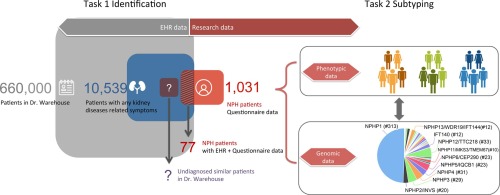Journal of Biomedical informatics ( IF 4.0 ) Pub Date : 2019-10-14 , DOI: 10.1016/j.jbi.2019.103308 Xiaoyi Chen 1 , Nicolas Garcelon 2 , Antoine Neuraz 3 , Katy Billot 4 , Marc Lelarge 5 , Thomas Bonald 6 , Hugo Garcia 4 , Yoann Martin 4 , Vincent Benoit 2 , Marc Vincent 2 , Hassan Faour 2 , Maxime Douillet 2 , Stanislas Lyonnet 7 , Sophie Saunier 4 , Anita Burgun 8

|
Rare diseases are often hard and long to be diagnosed precisely, and most of them lack approved treatment. For some complex rare diseases, precision medicine approach is further required to stratify patients into homogeneous subgroups based on the clinical, biological or molecular features. In such situation, deep phenotyping of these patients and comparing their profiles based on subjacent similarities are thus essential to help fast and precise diagnoses and better understanding of pathophysiological processes in order to develop therapeutic solutions. In this article, we developed a new pipeline of using deep phenotyping to define patient similarity and applied it to ciliopathies, a group of rare and severe diseases caused by ciliary dysfunction. As a French national reference center for rare and undiagnosed diseases, the Necker-Enfants Malades Hospital (Necker Children's Hospital) hosts the Imagine Institute, a research institute focusing on genetic diseases. The clinical data warehouse contains on one hand EHR data, and on the other hand, clinical research data. The similarity metrics were computed on both data sources, and were evaluated with two tasks: diagnoses with EHRs and subtyping with ciliopathy specific research data. We obtained a precision of 0.767 in the top 30 most similar patients with diagnosed ciliopathies. Subtyping ciliopathy patients with phenotypic similarity showed concordances with expert knowledge. Similarity metrics applied to rare disease offer new perspectives in a translational context that may help to recruit patients for research, reduce the length of the diagnostic journey, and better understand the mechanisms of the disease.
中文翻译:

罕见疾病的表型相似性:纤毛病诊断和亚型分型。
罕见疾病通常很难且很难被准确诊断,而且大多数都缺乏经过批准的治疗方法。对于某些复杂的罕见疾病,还需要使用精密医学方法根据临床,生物学或分子特征将患者分为同质亚组。因此,在这种情况下,对这些患者进行深入的表型分析并根据下一个相似性比较他们的概况对于帮助快速准确地诊断和更好地理解病理生理过程以开发治疗方案至关重要。在本文中,我们开发了使用深度表型定义患者相似性的新方法,并将其应用于纤毛病,纤毛病是由睫状功能障碍引起的一组罕见和严重疾病。作为法国国家罕见病和未诊断疾病的参考中心,内克尔儿童医院(Necker-Enfants Malades Hospital)(Necker儿童医院)拥有Imagine Institute,这是一家专门研究遗传疾病的研究所。临床数据仓库一方面包含EHR数据,另一方面包含临床研究数据。在两个数据源上都计算了相似性指标,并通过两项任务对其进行了评估:使用EHR进行诊断和使用特定于睫毛病的研究数据进行分型。在被诊断为纤毛病的前30名最相似患者中,我们的精确度为0.767。表型相似的亚型纤毛病患者显示出与专家知识的一致性。应用于罕见疾病的相似性度量为翻译环境提供了新的观点,可以帮助招募患者进行研究,缩短诊断过程的时间并更好地了解疾病的机制。











































 京公网安备 11010802027423号
京公网安备 11010802027423号